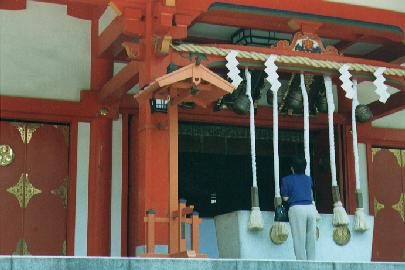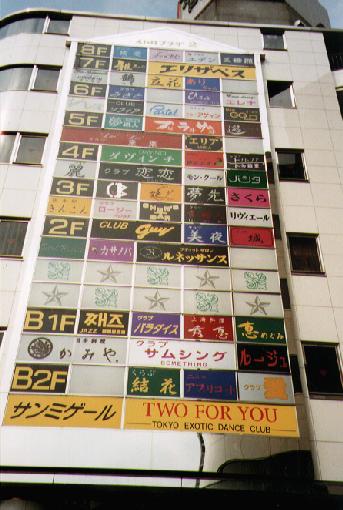


Above is a picture of some of my friends from Tokyo, I met
them all at a place called Mickey House that is located in Takanobaba which
is near Waseada University. Frequently, we would get together at Mickey
House and make our way down the street to the Mean Fiddler for some live
music and drinks.
 To
the right is a photo of Akiba in Tokyo. Akiba has a area filled with many
small electronics vendors. If you want a radio, stereo, computer, TV, etc,
then this is the place.
To
the right is a photo of Akiba in Tokyo. Akiba has a area filled with many
small electronics vendors. If you want a radio, stereo, computer, TV, etc,
then this is the place.
On weekends, this is a popular place for tourists to go
shopping. Unfortunately, with the strength of the yen, Akiba is not a place
for bargain hunters. However, you can frequently find cutting edge home
widgets for sale before they go on sale in the United States. Many Japanese
companies first sell their products and Tokyo, if they make the grade with
the Tokyo consumers, they may then sell the thingamajigs in the United
States.
 On July 4th,
I went to Camp Zama outside of Tokyo with my friends Midori and Kaori.
Camp Zama is a military base that is shared between the U.S. Army and the
Japan S. D. F. The day we went was very hot and humid so we didn't
stay as long as we had planned. While there, we saw a small motorcycle
rally (Harleys are very popular in Japan), a rock concert, some carnival
booths, and lots of food booths. Being Japan, everything was very expensive.
A box of chocolate chip cookies was selling for $5 which wasn't that bad
for Tokyo.
On July 4th,
I went to Camp Zama outside of Tokyo with my friends Midori and Kaori.
Camp Zama is a military base that is shared between the U.S. Army and the
Japan S. D. F. The day we went was very hot and humid so we didn't
stay as long as we had planned. While there, we saw a small motorcycle
rally (Harleys are very popular in Japan), a rock concert, some carnival
booths, and lots of food booths. Being Japan, everything was very expensive.
A box of chocolate chip cookies was selling for $5 which wasn't that bad
for Tokyo.
 In the heart
of Tokyo lies the Imperial Palace, unfortunately the palace is not generally
open to the public for viewing. To the left is a picture of a house (guard
house?) inside the moat of the imperial palace, the contrast of the traditional
building with the large office building in the background is good summary
of the heart of Tokyo.
In the heart
of Tokyo lies the Imperial Palace, unfortunately the palace is not generally
open to the public for viewing. To the left is a picture of a house (guard
house?) inside the moat of the imperial palace, the contrast of the traditional
building with the large office building in the background is good summary
of the heart of Tokyo.
 Visitors
are able to get a little closer to the Imperial Palace but not much. The
inner palace is accessible only over a few bridges which are closed to the
public
Visitors
are able to get a little closer to the Imperial Palace but not much. The
inner palace is accessible only over a few bridges which are closed to the
public
 About an hour,
by train, outside of Tokyo is an area called Kamakura. Kamakura is
a small town that is mainly used by people who wish to retreat away from
Tokyo. Being a coastal town, I met people who would travel there
to enjoy the beaches which were much nicer and cleaner than those within
Tokyo. Among many shrines and temples in the area, the biggest tourist
attraction was the Daibutsu which is pictured to the left.
About an hour,
by train, outside of Tokyo is an area called Kamakura. Kamakura is
a small town that is mainly used by people who wish to retreat away from
Tokyo. Being a coastal town, I met people who would travel there
to enjoy the beaches which were much nicer and cleaner than those within
Tokyo. Among many shrines and temples in the area, the biggest tourist
attraction was the Daibutsu which is pictured to the left.
 If you take
the JR Rail to Harajuku, you can get off and head into Yoyogi park.
Sunday is the day where the students do not have school. As a result, the
youth (particularly the punks) come out to the entrance to Yoyogi to see
and be seen.
If you take
the JR Rail to Harajuku, you can get off and head into Yoyogi park.
Sunday is the day where the students do not have school. As a result, the
youth (particularly the punks) come out to the entrance to Yoyogi to see
and be seen.

Also outside the park, you can find an occasional music
group displaying their talents. Until recently, there were numerous bands
playing on Sundays. However, the government has decided this should not
be permitted and you will only find one or two groups on a given Sunday.
 Yoyogi has
a few ponds and many trees around which to gather. Many people enjoy the
the serenity of the park as an escape from the hectic pace of Tokyo life.
Tokyo has some beautiful parks that are right in the middle of the city.
Yoyogi has
a few ponds and many trees around which to gather. Many people enjoy the
the serenity of the park as an escape from the hectic pace of Tokyo life.
Tokyo has some beautiful parks that are right in the middle of the city.
 Also in Yoyogi
park is Meji Shrine. To the left, you can see the entrance to the shrine.
The shrine is a very peaceful place set securely in the heart of Tokyo.
Also in Yoyogi
park is Meji Shrine. To the left, you can see the entrance to the shrine.
The shrine is a very peaceful place set securely in the heart of Tokyo.
When visiting the shrine, you are surrounded by the serenity
of nature and can easily forget you are in one of the worlds most populated
cities. Going to the shrine you will pass a great diversity of people.
Many Japanese will visit the shrine for perhaps more of a cultural reason
than the western concept of religion. Additionally, the shrines and temples
in and around Tokyo are popular tourist attractions for people from all
over the world
 At many of
the shrines, people will toss donations into the box before them, clap,
and bow (although I forget the exact numbers or sequence of the steps).
Each shrine in Japan will sell little tokens than have been blessed for
a various cause. Some are traditional for prosperity while others are more
modern such as safe driving.
At many of
the shrines, people will toss donations into the box before them, clap,
and bow (although I forget the exact numbers or sequence of the steps).
Each shrine in Japan will sell little tokens than have been blessed for
a various cause. Some are traditional for prosperity while others are more
modern such as safe driving.
The buildings in the shrine area are very traditional
and are a strong contrast to the modern sky scrapers that are out of your
sight but not more than 2km away. The traditional building in the natural
setting help evoke a nice feeling of relaxation and peace when you are
at the shrines.
 Another major
Tokyo park is Ueno. Ueno is less of a traditional park and more of an area
for museums that happens to have trees and pedestrian paths rather than
roads. A nice place to go but it lacked the same feeling that you can find
in the Yoyogi park/Meji shrine area.
Another major
Tokyo park is Ueno. Ueno is less of a traditional park and more of an area
for museums that happens to have trees and pedestrian paths rather than
roads. A nice place to go but it lacked the same feeling that you can find
in the Yoyogi park/Meji shrine area.
 Outside of
the park but near to Ueno station, there is a large arcade with a plethora
of little shops. You can find merchants selling clothes, groceries, electronics,
souvenirs and pretty much anything else under the sun. Unfortunately, this
area is also notable for the black market phone card trade which is openly
conducted on the street.
Outside of
the park but near to Ueno station, there is a large arcade with a plethora
of little shops. You can find merchants selling clothes, groceries, electronics,
souvenirs and pretty much anything else under the sun. Unfortunately, this
area is also notable for the black market phone card trade which is openly
conducted on the street.
 Shinjuku
lacks the glamour of Ginza and the "in vogue" feel of Shibuya
but none the less is popular with many of the 20-something crowd in Tokyo.
Pictured to the left is a shrine that is right in Shinjuku. In contrast
to Meji Shrine, this shrine is surrounded by houses, shops, etc.
Shinjuku
lacks the glamour of Ginza and the "in vogue" feel of Shibuya
but none the less is popular with many of the 20-something crowd in Tokyo.
Pictured to the left is a shrine that is right in Shinjuku. In contrast
to Meji Shrine, this shrine is surrounded by houses, shops, etc.
 One of the
more interesting aspects of the shrine is its locality to to the red-light
district of Shinjuku. Tour books claim this is one of the seedier areas
of Tokyo but I wasn't very impressed. There were many adult dance clubs
with young men and women trying to entice customers to enter but the area
did not feel very "seedy" to me. Perhaps it was just lost on
my since I was pretty much deaf and illiterate to most of what surrounded
me.
One of the
more interesting aspects of the shrine is its locality to to the red-light
district of Shinjuku. Tour books claim this is one of the seedier areas
of Tokyo but I wasn't very impressed. There were many adult dance clubs
with young men and women trying to entice customers to enter but the area
did not feel very "seedy" to me. Perhaps it was just lost on
my since I was pretty much deaf and illiterate to most of what surrounded
me.
 My final
image from my Tokyo trip is Shinjuku Gardens. On the opposite side of Shinjuku
from the earlier images, Shinjuku gyonen had a small admission fee (400
yen or so) but was well worth it. Carefully manicured gardens, plenty of
trees, and peaceful surrounds made this a pleasant place to sit and read
or sun bathe on a Saturday afternoon.
My final
image from my Tokyo trip is Shinjuku Gardens. On the opposite side of Shinjuku
from the earlier images, Shinjuku gyonen had a small admission fee (400
yen or so) but was well worth it. Carefully manicured gardens, plenty of
trees, and peaceful surrounds made this a pleasant place to sit and read
or sun bathe on a Saturday afternoon.
I enjoyed my, all to short, time in Tokyo and hope to return their in a few years to work. I would like to have the opportunity to explore more of the world of Japan. Meanwhile, I am continuing my studies of Japanese and perhaps, some year, I will be able to comfortably carry on a real conversation.
Howard Gobioff(hgobioff@cs.cmu.edu)